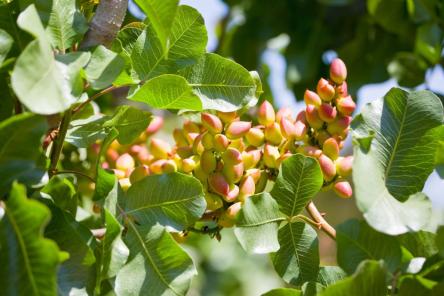Pistachios, also known as “the green gold,” have become increasingly popular in recent years.
Their demand has soared due to their unique taste, health benefits, and versatility in culinary applications.
.
 This surge in demand has presented a lucrative opportunity for entrepreneurs and investors to consider pistachio plantation as a business venture. In this article, we will explore the various aspects of pistachio plantations, highlighting its profitability, sustainability, and key considerations for potential investors.
This surge in demand has presented a lucrative opportunity for entrepreneurs and investors to consider pistachio plantation as a business venture. In this article, we will explore the various aspects of pistachio plantations, highlighting its profitability, sustainability, and key considerations for potential investors.
Profitability of Pistachio Plantations: Pistachio trees are known for their exceptional productivity and long-term viability, making them an excellent investment in the agricultural sector.
The financial returns from a pistachio plantation can be substantial, as it takes 5-7 years for pistachio trees to reach full maturity and start producing a significant yield.
The global demand for pistachios has been steadily increasing, contributing to a surge in prices.
This trend, coupled with the relatively low supply resulting from the tree’s extended period to yield, creates a favorable market for pistachio growers.
Moreover, the extended shelf life of pistachios allows for better price stability compared to other perishable crops, making it a resilient source of income for growers.
Factors to Consider:
1. Location: Selecting the right location for your pistachio plantation is crucial.
Pistachio trees require a dry climate with low humidity for optimal growth.
Areas with warm days, cool nights, and a long growing season tend to be ideal for their cultivation. Regions such as California, Iran, and Turkey have emerged as leading pistachio producers due to their suitable climate conditions.
2. Land and Infrastructure: Pistachio tree cultivation requires ample land, as each tree needs sufficient spacing to optimize sunlight exposure and airflow.
The land should also have good drainage and access to a reliable water source, as pistachio trees necessitate regular irrigation.
Adequate infrastructure, such as access roads and storage facilities, is essential for efficient harvesting and transport of the crop.
..
 3. Varietal Selection: Choosing the right pistachio varieties is critical for ensuring optimal yield and marketability.
3. Varietal Selection: Choosing the right pistachio varieties is critical for ensuring optimal yield and marketability.
Consult with agricultural experts to determine which varieties are best suited for your specific climate and growing conditions.
Factors to consider include tree size, nut size, shell splitting, and resistance to common diseases. Sustainability in Pistachio Plantations: Pistachio plantations offer several environmental benefits, making them an attractive investment from a sustainability perspective.
Pistachio trees are drought-tolerant and require fewer inputs in terms of water and fertilizers compared to other high-value crops.
This attribute makes pistachio cultivation an environmentally friendly option, contributing to water conservation and reducing the use of synthetic chemicals.
Additionally, the deep-rooted pistachio trees help stabilize soil, combat erosion, and improve overall soil health.
Proper land management practices, such as cover cropping and rotational farming, can enhance the ecological sustainability of the plantation.
Conclusion: Investing in a pistachio plantation holds promising potential for both financial success and sustainability.
The rising global demand, coupled with the unique characteristics of pistachio trees, makes it an attractive business opportunity.
However, it is crucial to consider various factors such as location, land suitability, infrastructure, and varietal selection to ensure profitable and sustainable operations.
With careful planning, technologically advanced farming techniques, and proper management, entrepreneurs and investors can embark on a rewarding journey with pistachio plantations, reaping the benefits of this “green gold.
“Marketing and Market Demand: Once you have established your pistachio plantation, it is essential to have a well-thought-out marketing strategy to capture and capitalize on the growing global demand for pistachios.
Market research should be conducted to identify potential buyers and understand their preferences and requirements.
This will help you tailor your production and marketing strategies accordingly.
…
 Expanding market access can also be achieved by participating in trade shows, exhibiting at agricultural fairs, and building relationships with distributors and retailers.
Expanding market access can also be achieved by participating in trade shows, exhibiting at agricultural fairs, and building relationships with distributors and retailers.
Utilize digital platforms and social media to create brand awareness and engage with both consumers and potential business partners.
Value-added products derived from pistachios, such as pistachio butter, oil, and flour, can also be explored to diversify your product range and maximize profitability.
Challenges and Risks: While pistachio plantations offer numerous opportunities, there are also some challenges and risks that must be considered.
Pests and diseases, such as aflatoxin contamination and fungal infections, can severely reduce yields and impact the quality of the crop.
Implementing integrated pest management and proper hygiene practices is crucial to mitigate these risks.
Changes in weather patterns, including droughts and extreme temperatures, can also pose challenges for pistachio plantations.
It is crucial to monitor and adapt to climate conditions, implementing irrigation and water management strategies to ensure the trees receive the optimal amount of water.
Additionally, fluctuations in global market prices and competition from other pistachio-producing regions can impact profitability.
Stay informed about industry trends, price forecasts, and market dynamics to make informed decisions and remain competitive.
Conclusion: Investing in a pistachio plantation can be a rewarding endeavor, offering both financial profitability and environmental sustainability.
However, it requires careful planning, thorough research, and a comprehensive understanding of the industry and market dynamics.
By considering key factors such as location, land suitability, varietal selection, and marketing strategies, entrepreneurs and investors can establish and operate a successful pistachio plantation.
Embrace technological advancements and sustainable practices to maximize productivity, mitigate risks, and ensure the long-term success of your venture.
Remember, the pistachio industry presents an exciting opportunity to be part of a growing market and contribute to the global demand for this delicious and nutritious “green gold.”




